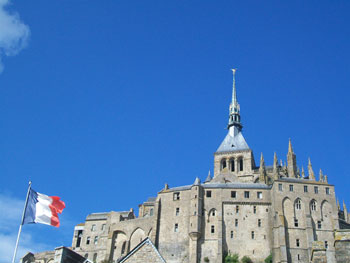
by Marc Latham
I once described Lisbon-Sintra’s Pena Palace as a ‘Disney castle resting in an environmentalist’s dream’ but after visiting Mont-St-Michel on the northern French coast this year I wasn’t surprised to read that it has actually inspired Disney movie castles. However, if the Pena Palace is a verdant vision, Mont-St-Michel is a marine masterpiece.
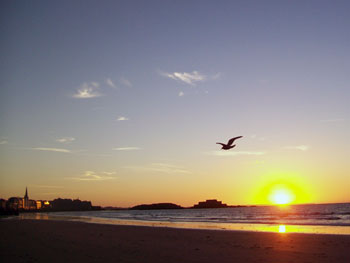 The ancient abbey rises out of sea and silt like the most triangular of mountains, seemingly balanced precariously on its rock without an inch of land wasted; and is big enough to be seen from the edge of its bay, over thirty kilometres (twenty miles) away. After I reached its public-access summit half way through my week-long holiday in France, Mont-St-Michel became the peak of my visit in more ways than one; a week that had started unplanned, and turned into an enjoyable trip down memory lane as well as one full of new sights.
The ancient abbey rises out of sea and silt like the most triangular of mountains, seemingly balanced precariously on its rock without an inch of land wasted; and is big enough to be seen from the edge of its bay, over thirty kilometres (twenty miles) away. After I reached its public-access summit half way through my week-long holiday in France, Mont-St-Michel became the peak of my visit in more ways than one; a week that had started unplanned, and turned into an enjoyable trip down memory lane as well as one full of new sights.
Looking for a short-holiday destination, Dinard was the cheapest flight available from my local Leeds-Bradford airport, but I’d never heard of it. So I looked it up, and read it was a town in Brittany, on the northern coast of Europe; neighbouring the historic port of Saint-Malo, which I did know. I also knew that Mont-Saint-Michel was nearby; a face of France I’d wanted to view since first seeing its Gothic visage.
It was also twenty-five years since I hitch-hiked through France at the start of my travels: then, I’d traveled just south of Brittany and Normandy from Paris to Bordeaux. So I booked the flight, and on an early-September Saturday I flew over my past life to the aquamarine seas, golden sand and stately villas of northern France’s Emerald Coast. After flying over Wales, where I grew up, we left the south coast of England and flew over the Channel Islands. It was the first time I’d seen my birthplace of Jersey since leaving as a young child, about forty-four years before.
 I relived some of my traveling past by hiking about 10km from the airport to my hotel, on the southern edge of Saint-Malo. The local bus service does not cater for the airport. I crossed the Rance estuary below Saint-Servan, which was called Aleth when a Welsh monk called Maclow became its bishop in the 6th century. It was from Maclow that a new community to the north took its name; Saint-Malo has since incorporated Saint-Servan within its city boundaries. Brittany still has a Celtic identity.
I relived some of my traveling past by hiking about 10km from the airport to my hotel, on the southern edge of Saint-Malo. The local bus service does not cater for the airport. I crossed the Rance estuary below Saint-Servan, which was called Aleth when a Welsh monk called Maclow became its bishop in the 6th century. It was from Maclow that a new community to the north took its name; Saint-Malo has since incorporated Saint-Servan within its city boundaries. Brittany still has a Celtic identity.
Seeing an Aldi supermarket along the way inspired another trip down memory lane. After booking into my hotel I returned to the Aldi; bought beer, bread and brie; and consumed them under a tree. Cars whizzed around the natural traffic island, but they were only reminders of my past; I didn’t have to think about getting a lift in the morning. The sun was more important to my immediate future, and I closely watched it slowly set through the overhanging branches and leaves; swallowing an evening’s thoughts into the tummy of tomorrow.
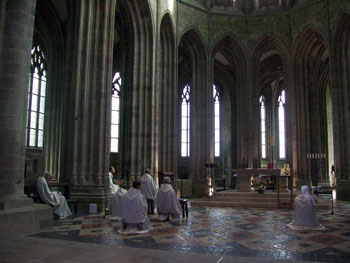 The next day I moved to Saint-Malo’s only hostel, which is ideally situated only two blocks from the Grand Plage: two miles of beach between the walled old town and the district of Parame. There hadn’t been any room at the hostel on the Saturday night. I spent the next couple of days getting to know the landmarks and beaches of Saint-Malo.
The next day I moved to Saint-Malo’s only hostel, which is ideally situated only two blocks from the Grand Plage: two miles of beach between the walled old town and the district of Parame. There hadn’t been any room at the hostel on the Saturday night. I spent the next couple of days getting to know the landmarks and beaches of Saint-Malo.
Saint-Malo’s walled old town looks more impressive the closer you get, and its visual impact is increased by forts and islands stretching out from its north-west corner to the horizon. Saint-Malo was itself an island before being linked to the mainland by a causeway. Its wall, which is seven metres thick in places, dates from the 14th century. Malouins had a fearsome reputation for pirating passing ships, and in 1590 not only declared Saint-Malo independent of France, but also from Brittany. Independence lasted four years.
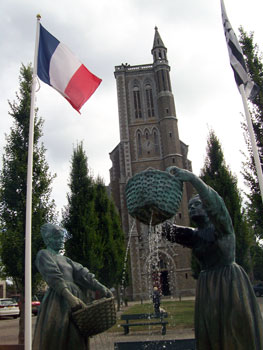 At low tide you can walk out to Fort National, Île du Grand Bé and Fort du Petit Bé. The former was built during the reign of Louis XIV in the late 17th century, and was named Fort Royale until the French Revolution a century later. It is open to visitors during the summer. Malouin writer Chateaubriand, cited as the founder of French Romanticism, is buried on Île du Grand Bé; a hilltop cross marks the site, and views stretching for miles to the western edge of the bay explain its Romantic reason.
At low tide you can walk out to Fort National, Île du Grand Bé and Fort du Petit Bé. The former was built during the reign of Louis XIV in the late 17th century, and was named Fort Royale until the French Revolution a century later. It is open to visitors during the summer. Malouin writer Chateaubriand, cited as the founder of French Romanticism, is buried on Île du Grand Bé; a hilltop cross marks the site, and views stretching for miles to the western edge of the bay explain its Romantic reason.
Returning to the city wall, there are a couple of small beaches on the western front. Steps lead up into the narrow cobbled streets of historic Saint-Malo. More steps rise to the Bastion de la Hollande, where a statue of Saint-Malo’s most renowned sailor points out to sea. Jacques Cartier sailed to the Americas in 1534, and is probably the man most responsible for Canada now being known as Canada. ‘Canada’ derives from an Iroquoian word for village or settlement; Cartier heard the word after asking directions, and then adapted it for the whole region. Cartier sailed as far as modern Montreal in search of a north-west passage to Asia, and claimed ‘Canada’ for the French.
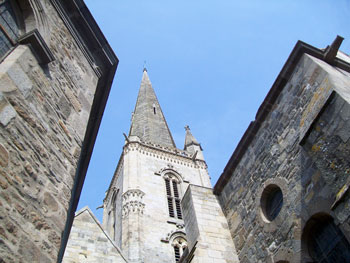 The cathedral is a central landmark and highlight, rising high above streets full of gift and clothes shops; crepe and seafood restaurants. Museums, a twentieth-century war memorial, and a central park are also of interest within the city walls; and regular plaques tell the historical significance of streets and buildings. Exiting the walls to the south, corsair sailing ships in the harbour are another reminder of the past.
The cathedral is a central landmark and highlight, rising high above streets full of gift and clothes shops; crepe and seafood restaurants. Museums, a twentieth-century war memorial, and a central park are also of interest within the city walls; and regular plaques tell the historical significance of streets and buildings. Exiting the walls to the south, corsair sailing ships in the harbour are another reminder of the past.
Getting itchy feet, I did a circular 20 kilometer hike to Cancale and back on the fourth day, crossing the peninsula to the east on the D355 road, walking along the coast on the D276 and D76, and returning west on the D155. Mont-Saint-Michel’s silhouette was visible from the edge of the bay, about 30km away as the crow flies. The sea shone green in the sun, justifying the coast’s Emerald moniker.
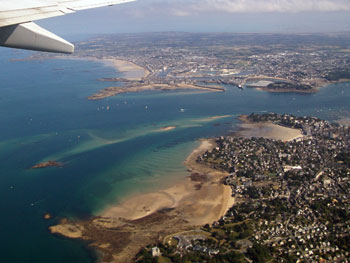 I took the coach from Saint-Malo to Mont-St-Michel at 9.15 the next morning. It is the only bus on that route, and a 20 Euros return ticket is required. The journey takes 75 minutes, and with the return leaving at 15.45 you have about five hours at the Mont. You cross from Brittany to Normandy on the journey.
I took the coach from Saint-Malo to Mont-St-Michel at 9.15 the next morning. It is the only bus on that route, and a 20 Euros return ticket is required. The journey takes 75 minutes, and with the return leaving at 15.45 you have about five hours at the Mont. You cross from Brittany to Normandy on the journey.
A chapel was first built on the island then known as Mont Tombe in the eighth century. Legend says the Archangel Michel appeared before Bishop Aubert of Avranches and ordered its building; Avranches is a town on the eastern edge of the bay. Mont-Saint-Michel has survived fires and blockades over the centuries, with rebuilding and renovations increasing the size of the abbey to its present splendour.
 There were grey skies when we arrived, but the view was still spectacular. I walked up the narrow winding streets crammed with shops and tourists to the abbey gift shop, where you buy a ticket to enter the abbey and highest tier possible. On the ascent, the causeway linking the Mont with the mainland stretches out to the south, between the grey silt of low tide sea and the green vegetation of natural land; dividing the bay arcing to the east and west. To the north there is only the abbey towering above you, crowned by a golden Saint Michel statue.
There were grey skies when we arrived, but the view was still spectacular. I walked up the narrow winding streets crammed with shops and tourists to the abbey gift shop, where you buy a ticket to enter the abbey and highest tier possible. On the ascent, the causeway linking the Mont with the mainland stretches out to the south, between the grey silt of low tide sea and the green vegetation of natural land; dividing the bay arcing to the east and west. To the north there is only the abbey towering above you, crowned by a golden Saint Michel statue.
After the gift shop, the last few flights of steps are indoors, before you emerge onto the western terrace, with the cathedral towering above you, and the north visible once again. People walking along the estuary silt looked ant-sized, and the bright emerald sea lining the horizon appeared incredibly distant. Upon entering the cathedral, I saw that a communion open to the public was soon starting, so I stayed for the hour-long service. After a monk rang the bells at midday, seven monks and nuns sang and spoke sweetly and serenely.
Then I slowly made my way down through the living-quarters of the abbey: great halls, narrowing chimneys, giant wheels, cavernous stores and colourful gardens all connected by spiraling steps. It seemed like no time at all before I stumbled into the back of the gift shop, surprised at the sudden end to my abbey experience.
Emerging once again onto the abbey hill, clear skies provided a contrasting view to the morning. The biggest difference was the Saint-Michel statue, which now gleamed in the sun against the blue background. I made the most of the time I had left, taking as much as I could in, before returning to the bus with five minutes to spare.
On my penultimate day I took the local bus to the quiet town of Saint-Briac-sur-Mer, via Dinard, traveling north of the airport; and spent my final day among the gift shops of Saint-Malo. I walked down memory lane once more before leaving, entering the airport the same way I’d exited it the week before. Although this time I only walked from Dinard, after busing it across the Rance.
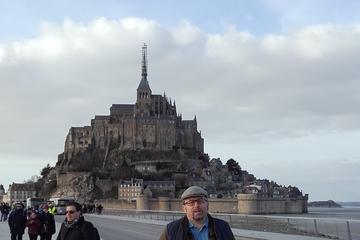
Private Full-Day Tour of Mont-Saint-Michel
If You Go:
Marc stayed at the F1 hotel, where the rooms were €35 per night for 1-3 people (double and single beds) and the Patrick Varangot hostel, where dorm beds and breakfast were €21 per person.
About the author:
Marc Latham traveled to all the populated continents during his twenties, and studied during his thirties, including a BA in History. He now lives in Leeds, and is trying to become a full-time writer from the www.greenygrey.co.uk website. Marc has several published and self-published books available on Amazon.
All photos are by Marc Latham.

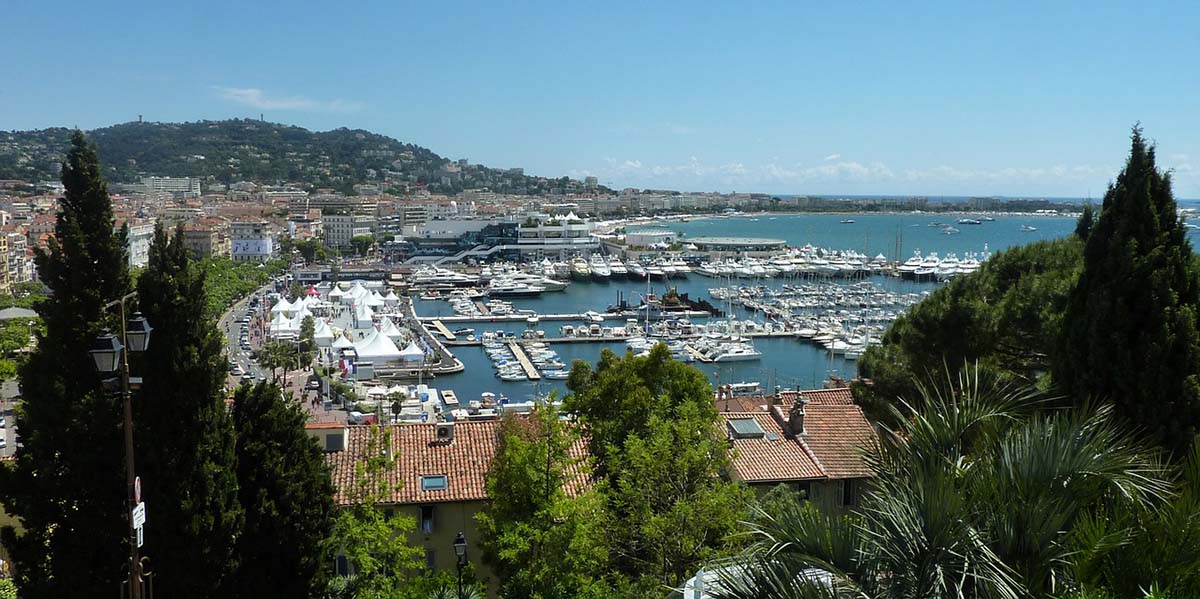
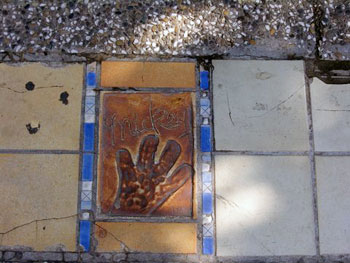 Cannes needs little introduction having achieved such film fame both Mickey Mouse and the Pink Panther themselves have left their hand prints in cement along its coastal promenade. Beach restaurants crowd the sands, taking possession of waterfront for their patrons and leaving but small tailings for the public. From the heights of its old castle can be seen the Cheshire Cat-smiling beach grinning out to sea. A sea filled with yachts to make a mariner drool and a beehive of business. Amid the watercraft run ferries to the nearby Lerin Islands, each isle staking its own claim to fame.
Cannes needs little introduction having achieved such film fame both Mickey Mouse and the Pink Panther themselves have left their hand prints in cement along its coastal promenade. Beach restaurants crowd the sands, taking possession of waterfront for their patrons and leaving but small tailings for the public. From the heights of its old castle can be seen the Cheshire Cat-smiling beach grinning out to sea. A sea filled with yachts to make a mariner drool and a beehive of business. Amid the watercraft run ferries to the nearby Lerin Islands, each isle staking its own claim to fame.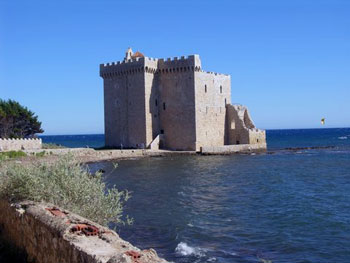 The largest, Ile Ste. Marguerite, holds the fortress, Fort Royal, and prison where the famed Man in the Iron Mask was held. Trails, museums and restaurants abound for the pleasure of tourists. We chose the smaller but no less interesting Ile St. Honorat where Cistercian monks have returned to a monastic life dating back to the 15th century. The church tower, rising high above waving palm trees, is readily visible from the coastal trail and overlooks the older remains of a fortified monastery jutting daringly into the very seas from which marauders came for plunder. The trail is dotted with chapels and legacies of war, though the contemporary peacefulness of the place makes turmoil seem so alien.
The largest, Ile Ste. Marguerite, holds the fortress, Fort Royal, and prison where the famed Man in the Iron Mask was held. Trails, museums and restaurants abound for the pleasure of tourists. We chose the smaller but no less interesting Ile St. Honorat where Cistercian monks have returned to a monastic life dating back to the 15th century. The church tower, rising high above waving palm trees, is readily visible from the coastal trail and overlooks the older remains of a fortified monastery jutting daringly into the very seas from which marauders came for plunder. The trail is dotted with chapels and legacies of war, though the contemporary peacefulness of the place makes turmoil seem so alien.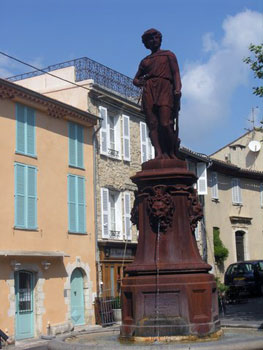 Mougins is, at first, unassuming until you learn the real medieval town is perched above the main road. It is a relatively short but steep climb to the jewel that draws tourists in their numbers. A less frequent bus travels the route if time and your patience permit. Most famed for its highly rated restaurants and the annual week-long Gourmet Festival it is equally appealing for its twisting narrow streets, plazas, galleries and studios. It appears as if the town has grown out of the hill itself as buildings rise and fall like protruding tree roots. The church bell chimed above us and echoed through the streets. Narrow lanes framed camera-ready shots. Life hums here.
Mougins is, at first, unassuming until you learn the real medieval town is perched above the main road. It is a relatively short but steep climb to the jewel that draws tourists in their numbers. A less frequent bus travels the route if time and your patience permit. Most famed for its highly rated restaurants and the annual week-long Gourmet Festival it is equally appealing for its twisting narrow streets, plazas, galleries and studios. It appears as if the town has grown out of the hill itself as buildings rise and fall like protruding tree roots. The church bell chimed above us and echoed through the streets. Narrow lanes framed camera-ready shots. Life hums here.
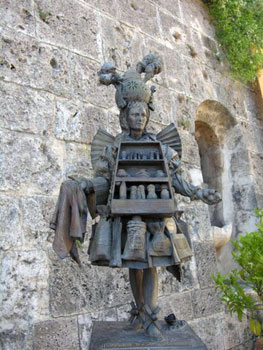 Tagging along with my wife and daughter I had little chance of avoiding perfumeries but more significantly the International Museum of Perfume. Even the limited range of my sniffer was awakened in this three level marvel which seemed to fit into the town like a piece from a jig saw. Everything you wanted to known about perfume is there. History, interactive aroma displays, a world of perfume containers from elegant to humorous and movies had us leaving more than two hours within its walls. When we emerged it was in another part of the town near a bronze statue of a parfumeur and a plaza with a spectacular view over the Mediterranean, incorporating Mougins and Cannes.
Tagging along with my wife and daughter I had little chance of avoiding perfumeries but more significantly the International Museum of Perfume. Even the limited range of my sniffer was awakened in this three level marvel which seemed to fit into the town like a piece from a jig saw. Everything you wanted to known about perfume is there. History, interactive aroma displays, a world of perfume containers from elegant to humorous and movies had us leaving more than two hours within its walls. When we emerged it was in another part of the town near a bronze statue of a parfumeur and a plaza with a spectacular view over the Mediterranean, incorporating Mougins and Cannes.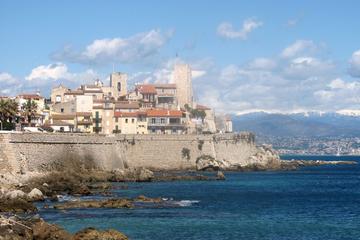
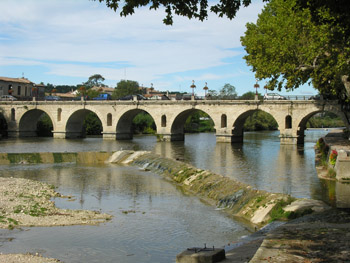
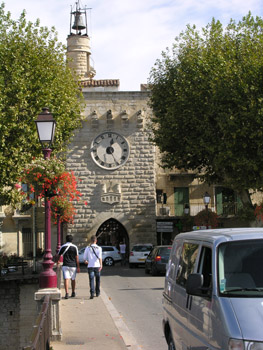 The Vidroule River flows leisurely along its defined banks flanked by nurtured trees and a tended walkway. A pastoral setting so peaceful we were entertained by a solitary otter swimming slowly by, oblivious to the nearness of people and cars. Cafes colonize the walkway with tented outdoor seating offering customers a tree shaded view of the Vidroule and its famous bridge. In its time the bridge was the only crossing of the Vidroule between the Mediterranean and the Cevenne Mountains; hence Sommieres’ ancient importance.
The Vidroule River flows leisurely along its defined banks flanked by nurtured trees and a tended walkway. A pastoral setting so peaceful we were entertained by a solitary otter swimming slowly by, oblivious to the nearness of people and cars. Cafes colonize the walkway with tented outdoor seating offering customers a tree shaded view of the Vidroule and its famous bridge. In its time the bridge was the only crossing of the Vidroule between the Mediterranean and the Cevenne Mountains; hence Sommieres’ ancient importance.
 Today the chateau, partially restored and turned to museum remembrances, recalls eras of siege and troubles. Initially constructed between the 10th and 11th centuries at its height it had two towers frowning over river and town of which but one remains. Its first mention in records was in 1041. As its prominence passed it was employed as a prison and eventually lapsed into partial private and public ownership. From its heights town and country spread out in a broad vista.
Today the chateau, partially restored and turned to museum remembrances, recalls eras of siege and troubles. Initially constructed between the 10th and 11th centuries at its height it had two towers frowning over river and town of which but one remains. Its first mention in records was in 1041. As its prominence passed it was employed as a prison and eventually lapsed into partial private and public ownership. From its heights town and country spread out in a broad vista.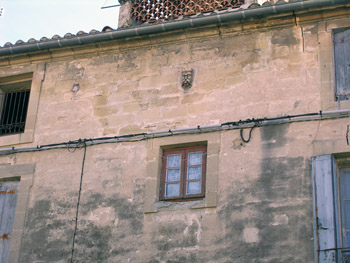 Sommieres, at 4,500 population, is not the prominent town it was those many years ago which makes it all the more inviting as it’s medieval heart continues to dominate and afford much for the wandering feet of visitors. Narrow streets and lanes sprout off in all directions yet maintain the Roman dominance of grid patterns. In some cases arches over streets have evolved into windowed buildings creating little tunnels to explore and, dotted throughout, are small arches spanning between buildings as some form of support. The narrowed confines open to readily framed vistas for telling photos.
Sommieres, at 4,500 population, is not the prominent town it was those many years ago which makes it all the more inviting as it’s medieval heart continues to dominate and afford much for the wandering feet of visitors. Narrow streets and lanes sprout off in all directions yet maintain the Roman dominance of grid patterns. In some cases arches over streets have evolved into windowed buildings creating little tunnels to explore and, dotted throughout, are small arches spanning between buildings as some form of support. The narrowed confines open to readily framed vistas for telling photos.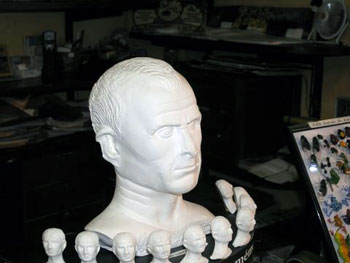
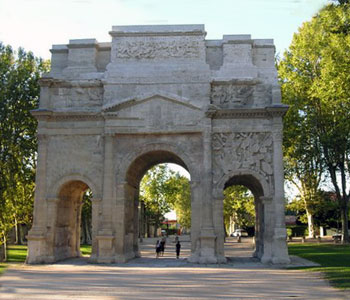 Sun washed Arles comfortably incorporates its dynamic vestiges of Rome into an appeal which draws throngs for a wealth of experiences. To all that is southern France, the food, wine, music, ambience, is also added the unique Van Gogh walking tour which takes toes wandering through town and discovering sites where Van Gogh created many of his greatest paintings.
Sun washed Arles comfortably incorporates its dynamic vestiges of Rome into an appeal which draws throngs for a wealth of experiences. To all that is southern France, the food, wine, music, ambience, is also added the unique Van Gogh walking tour which takes toes wandering through town and discovering sites where Van Gogh created many of his greatest paintings.
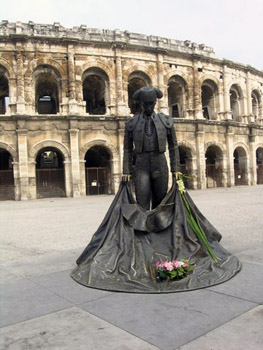 From its earliest days it was a haven for Celts worshiping at its natural springs. It became a Roman colony around 28 BC and bestowed upon it were edifices yet existing and functioning. The hand of Rome lay heavy upon this city.
From its earliest days it was a haven for Celts worshiping at its natural springs. It became a Roman colony around 28 BC and bestowed upon it were edifices yet existing and functioning. The hand of Rome lay heavy upon this city.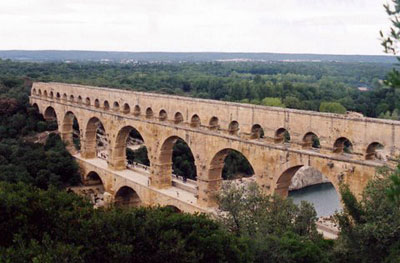 Though you cannot see it from the tower there is a seemingly unimportant ruin within the old city. A ruin that is the terminus of an amazing aqueduct system which once brought life giving waters 51 kilometres away from Uzes. Its most compelling attribute is the UNESCO World Heritage site at Pont du Garde. Here the aqueduct spanned the wide valley of the River Garde and though water no longer courses through its arteries it remains as a stunningly awe inspiring site. Its three arches rise high over the valley where once 200 million litres of water per day passed from Uzes to thirsty Nimes. It is claimed the system may have remained in use into the 9th century. Its continued use as a toll bridge helped the incredible structure survive. Today over 1.3 million visitors annually are drawn to the site and its associated museum.
Though you cannot see it from the tower there is a seemingly unimportant ruin within the old city. A ruin that is the terminus of an amazing aqueduct system which once brought life giving waters 51 kilometres away from Uzes. Its most compelling attribute is the UNESCO World Heritage site at Pont du Garde. Here the aqueduct spanned the wide valley of the River Garde and though water no longer courses through its arteries it remains as a stunningly awe inspiring site. Its three arches rise high over the valley where once 200 million litres of water per day passed from Uzes to thirsty Nimes. It is claimed the system may have remained in use into the 9th century. Its continued use as a toll bridge helped the incredible structure survive. Today over 1.3 million visitors annually are drawn to the site and its associated museum.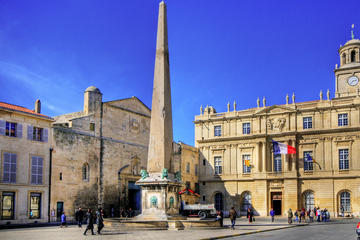
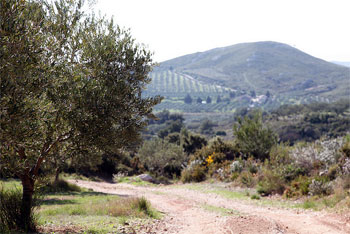
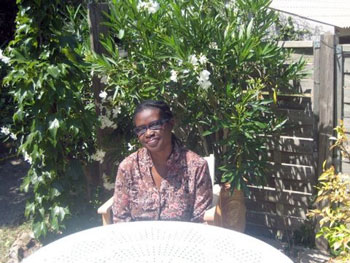 One week didn’t seem like a lot of time, my host at the residency pointed out, after circumstances required I cut my stay by a week. But it turned out to be one of the most productive for my writing in a long time. The residency, located just outside Aureille, provided plenty of uninterrupted time for reading, thinking, and writing, all of which I did copiously.
One week didn’t seem like a lot of time, my host at the residency pointed out, after circumstances required I cut my stay by a week. But it turned out to be one of the most productive for my writing in a long time. The residency, located just outside Aureille, provided plenty of uninterrupted time for reading, thinking, and writing, all of which I did copiously.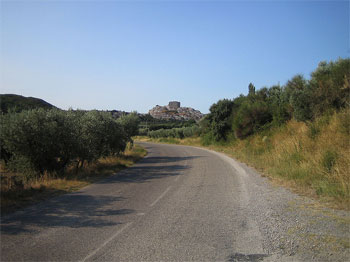 I spent my second day working on a short story, the concept for which I had been nursing for a while. The entire day, off and on, was spent working on this, and by the evening I was pleased to have finished the first draft. As I lay in bed that night, I contemplated how best to revise and improve my story. Falling asleep, however, did not follow naturally. My hosts keep no locks on their doors, since apparently in Aureille crime is practically unheard of. Unlocked doors always appear like an invitation to trouble for me and I braced the handle of my bedroom door with a chair and kept one of the lights burning to allow me a little peace of mind and some sleep.
I spent my second day working on a short story, the concept for which I had been nursing for a while. The entire day, off and on, was spent working on this, and by the evening I was pleased to have finished the first draft. As I lay in bed that night, I contemplated how best to revise and improve my story. Falling asleep, however, did not follow naturally. My hosts keep no locks on their doors, since apparently in Aureille crime is practically unheard of. Unlocked doors always appear like an invitation to trouble for me and I braced the handle of my bedroom door with a chair and kept one of the lights burning to allow me a little peace of mind and some sleep. That evening the hosts held a dinner for the artists around the pool. They wanted to hear my story that I had unfortunately been unable to present at the conference in Wales, having fallen ill. The warm approval on everyone’s faces and their requests to hear the story I was currently working on at the residency even though it was unpolished told me that perhaps I do have something to offer as a writer.
That evening the hosts held a dinner for the artists around the pool. They wanted to hear my story that I had unfortunately been unable to present at the conference in Wales, having fallen ill. The warm approval on everyone’s faces and their requests to hear the story I was currently working on at the residency even though it was unpolished told me that perhaps I do have something to offer as a writer.
 The following morning it was time to leave the residency. As I disposed of the garbage from my apartment, Angela, a Northern Irish artist who was also staying at the residency, was standing outside drinking her morning coffee. She asked me for my last name and thanked me for having shared my short story with the other artists on Saturday evening. “I will look out for your name,” she told me.
The following morning it was time to leave the residency. As I disposed of the garbage from my apartment, Angela, a Northern Irish artist who was also staying at the residency, was standing outside drinking her morning coffee. She asked me for my last name and thanked me for having shared my short story with the other artists on Saturday evening. “I will look out for your name,” she told me.
